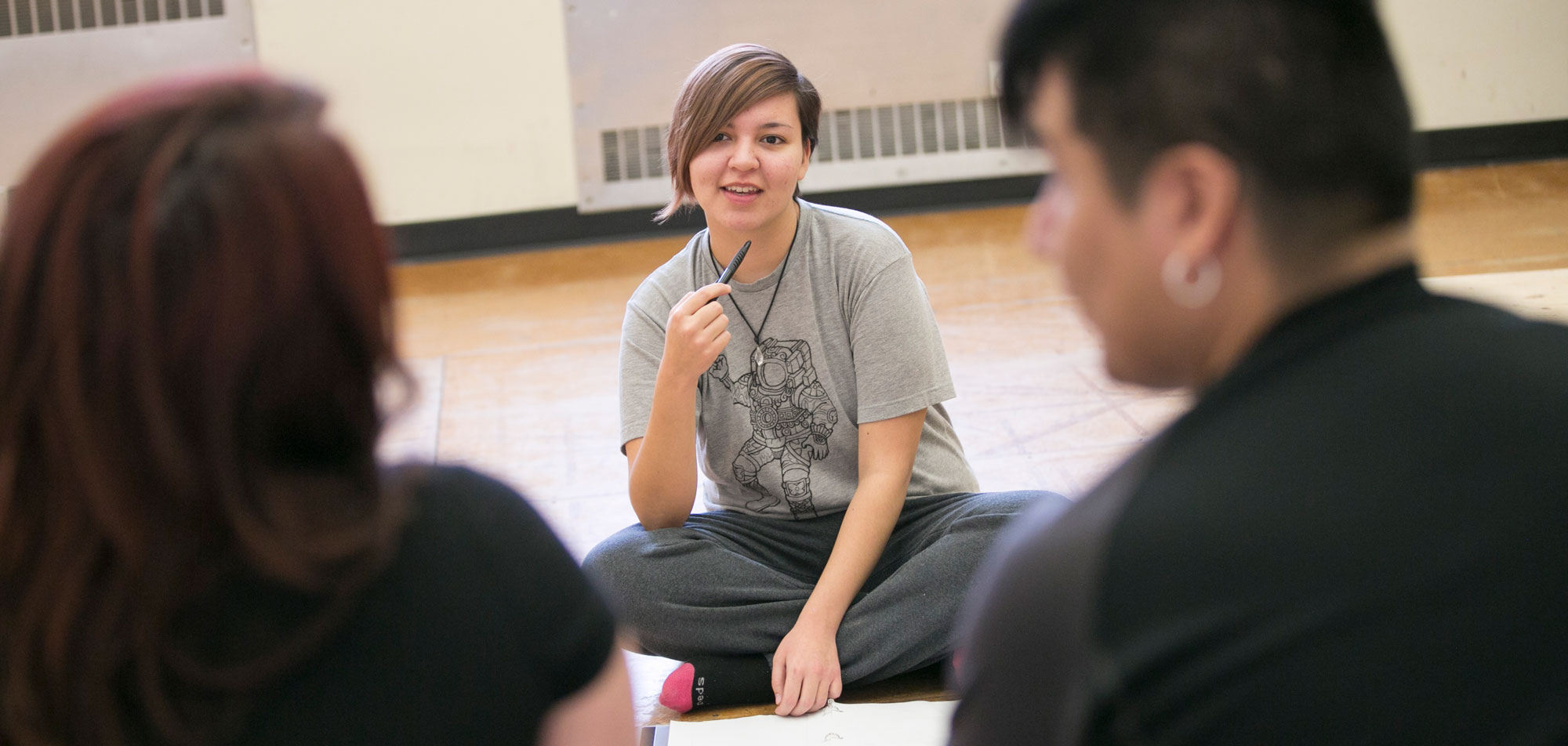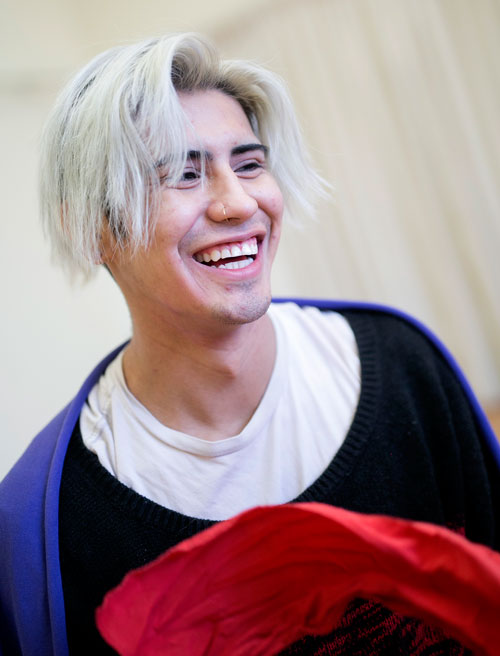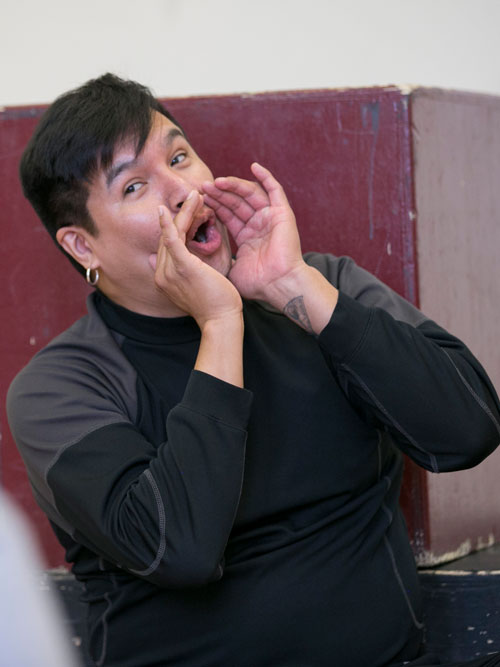LONG AGO IN A distant valley, a village of people lived at the shore of a deep lake. Each year, the strongest of the villagers would dive into the lake to collect the precious pearls that lay at the bottom. It was a test of bravery, because the pearls were guarded by a terrible monster.
In a creative exercise on a March morning, the students of the wîchêhtowin Aboriginal Theatre Program (ATP) are telling a new story together. A different voice adds each new line to the unfolding story.
In Cree, wîchêhtowin means “we are inclusive; we help each other,” and that’s what is happening here. Standing in a circle with their instructor, the students are creating something they could not create on their own.
These eight Indigenous students are experiencing the two-year program—the first of its kind at a Canadian university—as a single group, and after seven months together the warmth and camaraderie among them is already apparent. Yet amid the laughter, something important is happening in this room. Something urgent and overdue.
Assistant Professor Carol Greyeyes (BFA’82, BEd’88), their instructor and coordinator of the program, puts it bluntly: “I think we’re at a point where we need to start affirming our identity or we will completely lose it.”
A better path
Loss of identity is a danger Greyeyes understands well. In 1982, she completed a BFA in drama at the U of S, becoming one of Saskatchewan’s first Aboriginal fine arts graduates.
The experience was not a positive one. She remembers the underlying theme of the program being “leave who you are at the door.”

That suited her younger self well enough; as a 20-something student who had changed education and career paths a half-dozen times since high school, Greyeyes was undergoing her own identity crisis.
“I was very much in a phase of wanting to be anybody else but myself. So I latched onto whatever they were training me to be.”
At the time, that meant an actor in the traditional European mould. She studied the British theatrical canon, learned fencing and court dancing, and was coached in the Queen’s English. For three years, she tried her best to lose herself in the roles that fell her way.
“I came out with a slight British accent,” says Greyeyes, “and I just felt absolutely hollow.”
Greyeyes found a better path in the years that followed. She was given a chance to teach drama at Saskatoon’s Native Survival School and provide Aboriginal students the kind of theatrical training she wished she had been given.
“I just jumped at the opportunity, because I could see that theatre was a wonderful vehicle for affirming, empowering and enabling people to share. It was giving a voice to the voiceless.”
She carried that idea with her across the country—working in Toronto as artistic director for the Centre for Indigenous Theatre and as founding principal of the Indigenous Theatre School—as she built a celebrated career as an actor, director and writer.
Canadian drama programs have come a long way since Greyeyes’ student days in terms of embracing Canadian stories and celebrating diverse voices. But no university has offered anything like what Greyeyes helped pioneer at small training centres and workshops across the country: a program for Indigenous students, built around an Indigenous worldview.
Creating such a program was therefore one of her highest priorities when she joined the U of S Department of Drama as a faculty member.
“I achieved that in Toronto, but it still wasn’t here,” Greyeyes says. “And so I feel like I’ve come full circle.”

Shared understanding
As they complete the 10 courses needed for their certificate, ATP students will study acting, writing, set design and traditional forms of music and dance. Their most recent term included a playwriting course by Kenneth T. Williams and a guest lecture by musician Susan Aglukark. With the help of funds provided by private donors, the program has been able to incorporate additional cultural resources for the students: powwow dance and drum-making workshops, a pipe ceremony and teachings from elders.
Language is another cornerstone of ATP. As part of a new course titled Indigenous Performance Methods, students will undergo a weeklong immersion in an Indigenous language—Cree this time, perhaps a different language for the next group—and use it to create a performance piece.
“I feel it is absolutely essential that the Indigenous voice and worldview be incorporated into the program,” says Greyeyes. “Language is the vehicle for the worldview and values.”
Outside of those cultural components, the scene in an ATP acting class would look familiar to any student of drama on campus. They perform vocal and movement exercises; they play improv games; they rehearse scenes.

What’s different is what’s unspoken. The students in ATP have a shared cultural background: a shared understanding that they couldn’t count on in another setting. It’s what lets them rebound off each other’s improvisations with ease and agility, and what makes them feel comfortable enough to write stories about their own experiences—like Erryck Stokes’ first-ever play, a comedy about picking up status cards from the treaty commissioner’s office.
“Pretty much all the stories that I’ll be writing will be personal stories,” says Stokes, who is completing the program alongside a degree in biology.
The purpose of the program is not to segregate, says Greyeyes, but to build up the students’ skills using content that reflects who they are. Experience has shown her this is the first step towards other great things for students.
“Once they feel successful and confident, they take on anything.”
The power of the stage
When speaking with those involved with the program, one theme comes up repeatedly: the unique, intangible power of theatre to help participants find their voices.
It’s what brought Wanita Bird here. A youth worker with the Saskatoon Health Region, she discovered theatre’s potential while organizing a makeshift drama production as an outreach activity for teens on a nearby reserve.
“I saw kids who were very, very shy emerge from their shells and find their voice,” says Bird. “It was so empowering to see the change and see them channel their energy in a really positive way.”
Bird sees theatre as a therapeutic exercise: a mixture of play therapy and inner child work that teaches participants to better understand themselves. She enrolled in ATP with the intention of bringing what she learns back to the young people she works with.
Greyeyes describes the effect in different language. She says she thinks of live performance as a “spirit-to-spirit connection” that changes both performer and audience.
“You go on this journey together. It feeds your spirit. You leave that experience different than when you entered.”
Stokes says he has always been withdrawn socially, but signed up for the program on an impulse. He has noticed changes within himself, and gives credit to exercises in class—and the support of classmates—that “take away blocks you set up in your mind.”
“They really push you to be yourself. You feel really naked and exposed at first, but it’s nice to know that people want to be your friend after you’ve exposed yourself that much.”
Stokes, who has spent much of his life avoiding moments in the spotlight, is now actively pursuing a career in the public eye. This spring, he was preparing for a trip to Australia after being chosen through an international model casting call.

“I’m super excited for it,” he says. “I’m not scared at all. I’m ready for whatever the world’s got for me.”
A new generation
In the spring of 2017, after two years together, the eight students of the Aboriginal Theatre Program will end their journey with the performance of a never-before-seen stage production. No one knows yet what it will look like.
Greyeyes and the other instructors won’t dictate the content; it will be created by the students.
As her students’ voices grow stronger, Greyeyes realizes she is witnessing one small piece in the development of contemporary Indigenous culture. These students, and the groups that follow them, will go out into the world and help shape the fabric of Canada from stages, screens, communities and classrooms.
ATP’s tagline is “Creating new stories for a new generation.” It’s crucial, says Greyeyes, for Aboriginal people to have a way to tell stories about their place in the 21st century.
“All we’re doing is giving them tools to be able to express that. We’re creating the environment, bringing people in and asking, ‘Who are you, and how do you see the world?’”
Like everyone else, she is excited to see how they answer.